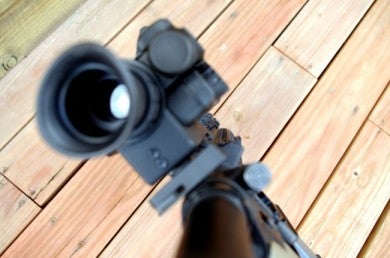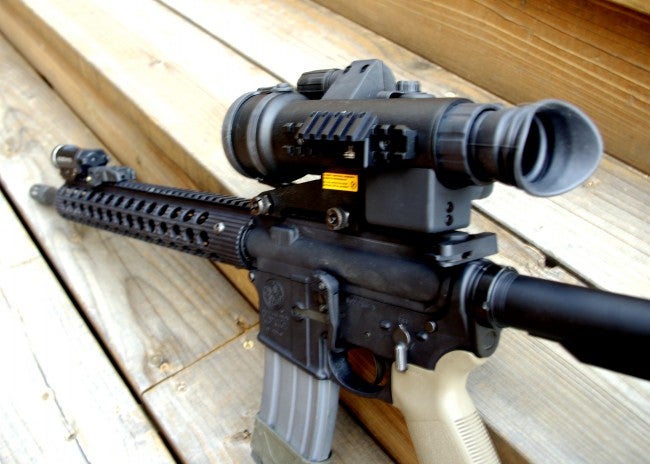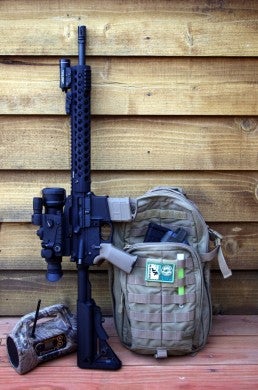If you live in a jurisdiction that allows the use of a night vision device for hunting or predator control, the Pulsar Sentinel GS 2X50 Night Vision Riflescope would be an excellent choice. Since I am constantly trying to get ahead of the coyote problem on our ranch I was excited to test a night vision rifle scope to see if it would be a good tool for managing coyotes…especially since we are several weeks away from calving.
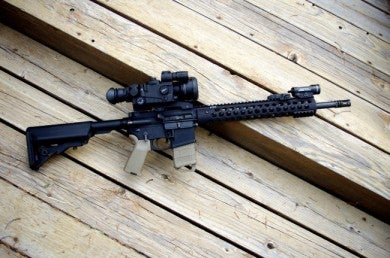
S&W M&P 15 with Pulsar Sentinel GS 2×50 Night Vision Rifle Scope. *Click on picture for high resolution photo.
Pulsar has a very broad product line that includes Generation 1, 2, and 3 night vision monoculars, binoculars, range finders, and rifle scopes. Pulsar also has several outstanding digital night vision products. The model that I tested featured Pulsar’s Proprietary CF- Super image tube. The CF-Super image tube consists of a sphere-shaped photocathode that provides a very clear, non-distorted image that comes close to that of a Generation 2 image. Key features found on the Pulsar Sentinel GS 2×50 Night Vision Riflescope include:
- Generation 1+ Proprietary CF- Super Image Tube
- 2 x magnification
- Weight of 35.2 ounces (2.20 pounds)
- 50mm Objective Lens
- A focus range of 5 meters to infinity
- 13 degree field of view at 50 meters
- Diopter Adjustment of +/- 2.5
- Runs on two AA batteries. Average battery life is 70 hours without IR
- Red and Green reticles
- Titanium body
- Built in adjustable IR illumination
- MIL – STD – 1913 Rail attached at the 9 o’clock for an additional light source.
- IPX4 water rating.
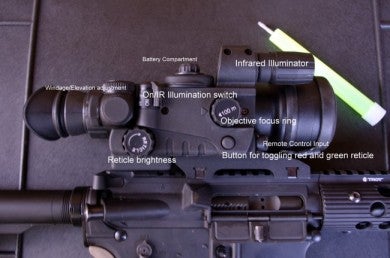
Pulsar Sentinel controls. All controls can be manipulated with gloves. *Click on picture for high resolution photo.
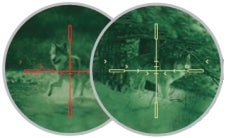
The Pulsar Sentinel GS 2×50 reticle options. Reticles are toggled by a button on the side of the unit. Photo courtesy of Pulsar.
Setting up my Ar-15 in preparation for testing and hunting, I found the weight of the scope wasn’t as bad as I thought it would be. The Pulsar Sentinel GS 2×50 weighs 35 ounces/2.2 pounds , and aside from feeling a little “top heavy”, the scope didn’t feel any heavier than my Bushnell HDMR (32 ounces/2 pounds). The ar-15 that I would be using for testing and hunting was my Smith & Wesson M&P 15. The fire control and bolt carrier group were replaced with Colt parts and after several thousand rounds the gun has been utterly reliable. I think that if I were running a heavier rifle I would attach a Magpul AFG or a vertical fore grip several inches from the magwell to allow greater control of the rifle. Due to the size of the Pulsar Sentinel GS 2×50 I wasn’t able to successfully utilize a red dot scope in an offset position. I did maintain my Streamlight TLR 1S in the 12 o’clock position as a backup just in case I had an angry wounded coyote charging me.
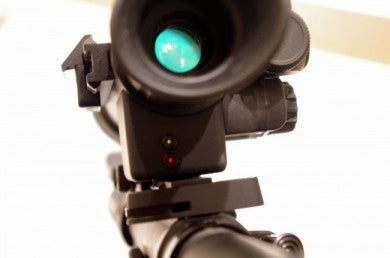
Indicator lights. Top light shows if the device is on. Bottom light shows if the IR illuminator is on. Device and IR Illuminator are both on.
Testing was done on our ranch. I sighted in the Pulsar Sentinel GS 2×50 using a laser bore sight. After a few adjustments I settled for a 50 yard zero. Since the scope is only a 2x I found it extremely hard to shoot anything less than a 5 inch group at 100 yards. After initial sight in I simulated a feral hog feeding station and setup up an 8 inch by 8 inch steel plate at 100 yards. I had no problems hitting steel at 100 yards from the prone position. I didn’t try to shoot past 100 yards. The controls on the Pulsar Sentinel GS 2×50 were very easy to manipulate with gloves on. Air temperature according to my Kestrel was 28 degrees Fahrenheit and I didn’t experience any issues with batteries or the unit losing power.
I didn’t experience any “blooming” effect when firing due to the A2 flash hider on my rifle. I strongly recommend using a flash hider or a suppressor when hunting with night vision. I can’t stress how clear the image was for being a Generation 1 tube. I have owned several Generation 1 night vision devices, and Pulsar’s CF-Super image tube created an image that was very similar to that of a Generation 2 image. There was no distortion around the edges, nor was there a “fish eye” effect. Testing was done on a clear night with plenty of moon light. I was amazed how far I could see through the scope. From an elevated position I could see all the East boundaries of the ranch, our working pens, telephone poles, fence lines, and the Gallinas Mountains, which were about 10 miles away.
Several weeks after initial sight in and testing, my cousin and I returned to the ranch to try to call in some coyotes. My cousin was armed with a 20 gauge Remington 870 shotgun, and a red lensed Surefire high lumen flashlight. After a 5 minute safety brief at the vehicle we wove some green glow sticks through the MOLLE attachments on our packs (Coyotes have a hard time seeing the green/520 -570 nm and red/620-740 nm color spectrums….hence the green glow sticks and the red lensed Surefire) and quietly headed into a pasture far from our main cattle herd. After putting about a quarter mile between us and our vehicle we started calling using a Foxpro Firestorm. The call used was a distressed calf and since we were set up next to a barbwire fence, we would give the fence a shake to simulate a baby calf caught in the barbwire. As I called, my cousin would slowly scan the prairie with his red lensed Surefire looking for the telltale eyes of a coyote. After 15 minutes of calling and experiencing no luck we decided to move our stand. I did a quick scan through the Pulsar Sentinel GS 2×50 and didn’t see anything. Packing up we hiked another 20 minutes, deployed the Foxpro and started a distressed rabbit call. Several minutes into the call my cousin tapped my shoulder and pointed towards a glowing set of eyes. Peering through the rifle scope I made out the bushy tale and large ears of a gray fox….a common yet very elusive animal on the ranch. We do not shoot the foxes on our ranch because they are vital for controlling the rodent population and are instrumental in maintaining a healthy eco system…they also pose no threat to our cattle. Several moments of observation passed before the fox picked up our scent, nodded as if to say “vaya con dios, amgios”, turned and trotted away. Several stands later and we had neither called nor heard any coyotes in the area and we decided to pack it up and head home.
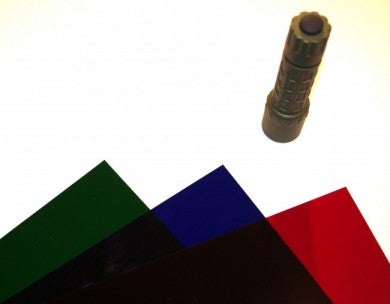
Do you have an old xenon bulb Surefire light you are not using anymore? You can use green or red photo gels for varmint hunting. Want to make an IR filter? Alternate the red and the blue gels until you can’t see any near IR light. *Don’t look directly at the light. Check Local, State and Federal laws before hunting with an artificial light source.
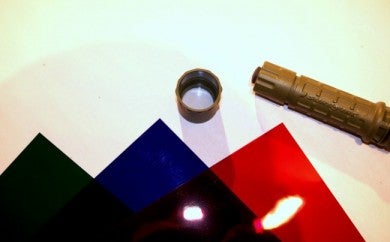
Depending on what I am doing I will simply cut the gel to fit inside the bezel. As long as you don’t run the light for a long time you shouldn’t have an issue with heat melting your gel.
Final Thoughts
The Pulsar Sentinel GS 2×50 Night Vision Rifle Scope is a no-nonsense piece of hardware that delivers a quality image and would be perfect for hunting feral hogs or predators at night. Before you hunt with night vision please check your Local, State, and Federal laws. While I was testing the Pulsar Sentinel I was constantly evaluating the scope for Law enforcement/Military potential. I feel this scope strictly belongs in the hunting realm. With that said, Pulsar offers some incredible products that would be excellent for Military or Law Enforcement use.
Pulsar will be at the 2014 SHOT show, booth # 1414!
Do you have any experience hunting with night vision? Tips, questions, sarcasm, gripes and jokes are welcome in the comments below!
Load that bipod…stay safe!
 Your Privacy Choices
Your Privacy Choices

